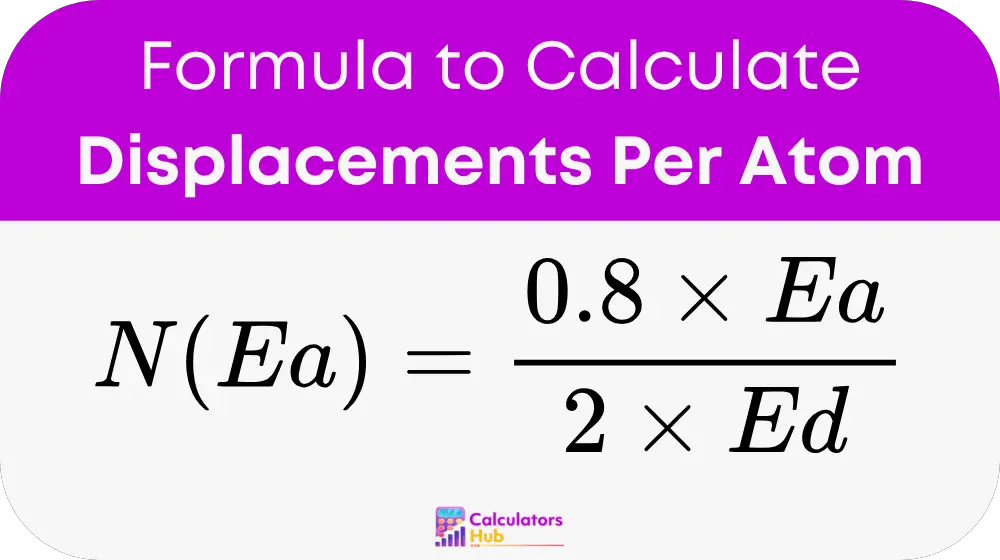The Displacements Per Atom (DPA) Calculator is a specialized tool used in nuclear materials science to estimate the number of times an atom in a solid is displaced from its lattice position due to energetic particle interactions, such as neutron or ion irradiation. This calculation plays a critical role in understanding material degradation in nuclear reactors, fusion devices, and space environments, where high-energy particles interact with structural materials.
This calculator uses standard models, such as the Norgett-Robinson-Torrens (NRT) formula, to provide a fast and accurate estimate of radiation damage. It is commonly used by researchers, physicists, and engineers to assess material lifetime, mechanical strength under irradiation, and compliance with safety standards.
Formula of Displacements Per Atom Calculator
The NRT model is widely accepted for estimating the number of atomic displacements (N) based on energy deposition:

Where:
- N(Ea) is the number of displacements per atom.
- Ea is the energy available for displacement, also known as damage energy (measured in electron volts, eV).
- Ed is the threshold displacement energy, or the minimum energy required to displace an atom from its lattice site (also in eV).
- The constant 0.8 accounts for the efficiency of energy transfer to atomic motion rather than other processes like ionization.
Step-by-Step Calculation:
- Determine the energy transferred to the atom (Ea).
- Obtain or estimate the material-specific Ed value.
- Use the formula to calculate how many atoms are displaced on average.
General Terms Related to Displacements Per Atom
| Term | Description |
|---|---|
| Displacements Per Atom (DPA) | Number of times an atom is knocked out of place by radiation. |
| Damage Energy (Ea) | Energy transferred to an atom that can cause displacement. |
| Threshold Displacement Energy (Ed) | Minimum energy needed to displace an atom from its lattice. |
| NRT Model | Standard formula for estimating displacement events. |
| Lattice Structure | Ordered atomic arrangement in crystalline materials. |
| Neutron Irradiation | Exposure to neutrons, commonly in nuclear reactors. |
| Ion Implantation | Process where ions are accelerated and embedded into materials. |
| Material Degradation | Reduction in performance or structure due to radiation exposure. |
| Electron Volts (eV) | Unit of energy commonly used in atomic-scale calculations. |
| Radiation Damage | Physical disruption in solids due to high-energy particle impacts. |
This table helps users understand the key concepts and search terms related to atomic displacement calculations.
Example of Displacements Per Atom Calculator
Let’s say a neutron imparts Ea = 30 eV of energy to a metal atom, and the threshold displacement energy Ed = 15 eV.
Use the formula:
N(Ea) = (0.8 × 30) / (2 × 15) = 24 / 30 = 0.8 displacements
So on average, each such interaction causes 0.8 atoms to be displace from the lattice. This is a theoretical average and can accumulate over many such events to indicate the total DPA in the material.
If millions of interactions occur, the total displacements can be significant, influencing the structural integrity of the material.
Most Common FAQs
DPA stands for Displacements Per Atom. It quantifies how many times, on average, each atom in a material is displace due to radiation over a given period.
The Norgett-Robinson-Torrens (NRT) model provides a simplified but standardized way to estimate radiation damage using only two inputs: damage energy and threshold displacement energy. It’s widely use in the nuclear industry due to its practicality.
Materials with tightly bound atomic structures, such as tungsten or silicon carbide, usually have higher Ed values. This means they are more resistant to atomic displacement, making them useful in high-radiation environments.
< /div>